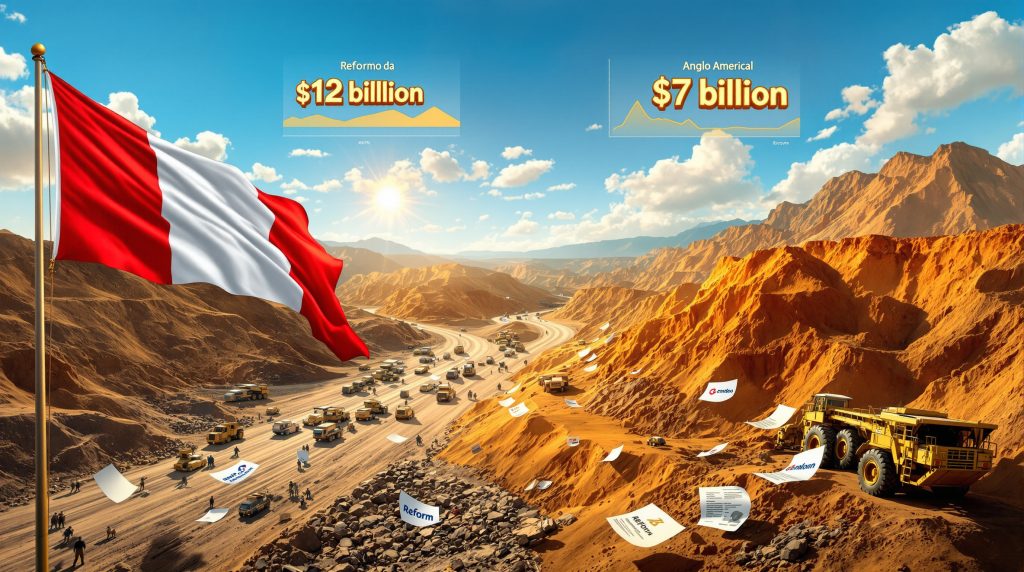Peru's Mining Concessions Reform: Balancing Rights, Investment, and Social Demands
Peru's mining concession system, a cornerstone of its position as the world's third-largest copper producer and South America's leading gold exporter, faces unprecedented scrutiny. The current framework grants large mining companies like BHP, Glencore, and Anglo American extensive exploration rights for decades before production begins. However, this system is now under threat as lawmakers consider Peru's mining concessions reform that could fundamentally alter the mining landscape.
The tension stems from competing interests: large-scale miners who require long-term security for multi-billion dollar investments versus small-scale operators who argue that concessions remain idle for too long. This conflict has intensified amid rising illegal mining activities and production delays at major projects, highlighting the need for permitting process insights.
Key Factors Driving the Reform Debate
- Estimated $12 billion in illegal gold mining exports for 2025
- Approximately $7 billion in future copper projects stalled due to illegal mining invasions
- Average 40-year timeline from concession to production for large-scale mines
- Growing political pressure to prioritize immediate economic benefits from small-scale operations
How Would the Proposed Reforms Change Peru's Mining Landscape?
The Peruvian Congress is currently debating legislation that would significantly alter the mining concession framework. These proposals primarily focus on updating regulations for small-scale miners but contain provisions that could impact large-scale operations as well.
Potential Reform Elements
- Shortened Concession Periods: Reducing exploration rights from decades to potentially as little as 10 years
- Use-It-or-Lose-It Provisions: Mechanisms to revoke concessions deemed idle or underutilized
- Formalization of Small-Scale Mining: Creating pathways for artisanal miners to operate legally
- Revised Permitting Process: Potential streamlining of bureaucratic procedures that currently delay project development
Mining executives warn these changes could severely impact investment confidence in a sector that represents approximately 10% of Peru's GDP and over 60% of its exports. The uncertainty has already prompted concerns from international investors about the security of their mineral rights.
Why Are Large Mining Companies Concerned?
Major mining corporations view the potential reforms as an existential threat to their business model in Peru. Their concerns center around several key issues:
Critical Concerns for Large-Scale Miners
- Investment Security: Long-term concessions provide the certainty needed for billion-dollar investments
- Development Timelines: The average 40-year timeline from exploration to production makes shortened concession periods impractical
- Regulatory Burden: Excessive bureaucracy already delays project development, making accelerated timelines unrealistic
- Illegal Mining Pressure: Claims that illegal miners are driving the reform agenda to legitimize their operations
Carlos Gallardo, general manager at the Peruvian Institute of Economics, emphasized this disconnect: "To consider cutting down concession time periods to 10 years or so is nonsense that will ultimately disincentivize large-scale formal mining investment."
What Role Does Illegal Mining Play in the Reform Debate?
The rise of illegal mining operations has significantly complicated Peru's mineral rights landscape. These operations not only represent lost tax revenue but also create environmental damage and social conflicts.
Impact of Illegal Mining
| Aspect | Data/Impact |
|---|---|
| Estimated Illegal Gold Exports (2025) | $12 billion |
| Major Projects Affected by Invasions | Southern Copper's Michiquillay and Los Chancas; First Quantum's Haquira |
| Potential Investment Delayed | $7 billion |
| Environmental Impact | Mercury contamination, deforestation, water pollution |
Industry consultants like Ivan Arenas suggest illegal miners are strategically pushing for reforms: "They're making up lies to try to legitimize taking over third parties' concessions that aren't theirs. It feels like their message is starting to stick."
How Has the Government Responded to Mining Reform Pressures?
The Peruvian government has taken a cautious approach to the reform debate. President Dina Boluarte mentioned "changes to the concessions regime" during her closing speech at the recent Perumin mining conference but offered no specific details.
The mining ministry has declined to comment on potential reforms, suggesting the government may be waiting to see how congressional discussions evolve. This uncertainty is likely to continue through Peru's presidential and legislative elections scheduled for next year, further complicating industry consolidation pressures.
Government Considerations
- Economic Impact: Mining represents approximately 10% of GDP and over 60% of exports
- Investment Climate: Need to maintain Peru's attractiveness for international mining investment
- Social Pressures: Growing demands from communities and small-scale miners for greater access to mineral resources
- Electoral Politics: Mining reform likely to be a major issue in upcoming elections
What Evidence Supports Maintaining the Current Concession System?
The Peruvian Institute of Mining Engineers recently commissioned a study from the Peruvian Institute of Economics (IPE) to analyze the importance of maintaining the existing concession framework.
Key Study Findings
- The average mine takes approximately 40 years to progress from concession to production
- Proposals to revoke "unused" concessions ignore the reality of mining development timelines
- Bureaucratic permitting processes, not company inaction, cause many delays
- Large-scale mining provides greater economic benefits through taxes, formal employment, and infrastructure development
The study concludes that shortening concession periods would effectively eliminate long-term mining investment in Peru, potentially devastating the country's economic future. According to Bloomberg, large miners fear their exploration rights are increasingly at risk in the current political climate.
How Do Social and Environmental Factors Influence the Reform Debate?
Beyond the economic considerations, Peru's mining concession reform debate is shaped by complex social and environmental factors.
Social Dimensions
- Community Rights: Many local communities demand greater benefits from mining activities
- Artisanal Mining Livelihoods: Thousands of families depend on small-scale mining for survival
- Regional Development: Mining can either support or hinder local development, depending on implementation
- Indigenous Concerns: Many mining areas overlap with indigenous territories, raising questions of prior consultation
Environmental Considerations
- Regulatory Oversight: Large miners face strict environmental requirements; illegal operations typically ignore regulations
- Remediation Capacity: Major companies have resources for environmental remediation; small operators often don't
- Water Management: Mining impacts on water resources are a critical concern for communities
- Land Rehabilitation: Long-term concessions include commitments for eventual site rehabilitation
What Are the International Implications of Peru's Mining Reforms?
Peru's potential mining reforms come amid growing global competition for mining investment, particularly for critical minerals needed for energy transition technologies. Understanding these reforms requires knowledge of broader industry evolution trends affecting the sector globally.
Global Context
- Investment Competition: Countries worldwide are competing to attract mining investment
- Supply Chain Security: Major economies seeking secure supply chains for critical minerals
- ESG Standards: Rising expectations for environmental and social governance in mining
- Copper Market: Peru supplies approximately 10% of global copper, making its policies globally significant
Changes to Peru's concession system could potentially redirect billions in investment to other mining jurisdictions if investors perceive increased risk to their mineral rights.
What Potential Compromises Could Address Both Large and Small Mining Concerns?
Finding middle ground between the interests of large mining companies and small-scale operators presents significant challenges but may be necessary to resolve the current impasse.
Potential Compromise Approaches
- Tiered Concession System: Different rules for different scales of operation and mineral types
- Improved Permitting Efficiency: Streamlining bureaucratic processes to accelerate project development
- Formalization Pathways: Creating legitimate opportunities for small-scale miners without undermining existing rights
- Shared Infrastructure: Developing mechanisms for small operators to utilize infrastructure developed by larger companies
- Community Benefit Agreements: Ensuring local communities receive tangible benefits from mining activities
Jose Farfan, legal adviser for Anplaben (a trade association representing processing plants that buy ore from artisanal producers), notes the complexity: "There is no consensus right now in congress. It is a taboo subject." The situation highlights the importance of studying different claims framework examples from other mining jurisdictions.
What's Next for Peru's Mining Concession Reform?
The future of Peru's mining concession system remains uncertain as congressional debates continue and elections approach. Several factors will influence the outcome:
Key Determinants for Reform Outcomes
- Congressional Dynamics: Fragmented political landscape makes consensus difficult
- Electoral Politics: Mining reform likely to be a major campaign issue in upcoming elections
- Industry Advocacy: Mining companies actively lobbying to protect their interests
- International Pressure: Foreign investors and governments concerned about supply chain impacts
- Community Mobilization: Local communities and small-scale miners organizing to influence the process
The resolution of this debate will significantly impact Peru's economic future, particularly its ability to capitalize on growing global demand for copper and other minerals essential for the energy transition. According to EITI reports, Peru's extractive sector governance will require careful balancing of multiple stakeholder interests.
FAQ About Peru's Mining Concession Reforms
Why do mining companies need such long concession periods?
Mining projects require extensive exploration, feasibility studies, environmental assessments, community consultations, and permitting processes before construction can begin. In Peru, this process averages 40 years from initial concession to production, requiring long-term security of mineral rights to justify the massive upfront investments.
How significant is illegal mining in Peru?
Illegal mining has become a major economic and environmental issue in Peru. Estimates suggest illegal gold mining alone will generate approximately $12 billion in exports in 2025, operating outside regulatory oversight and tax obligations while causing significant environmental damage.
Could reforms actually increase mining production in Peru?
Proponents argue that reforms could accelerate development by forcing companies to either develop concessions more quickly or relinquish them to operators who can. However, industry experts counter that the complex permitting process, not lack of motivation, causes delays, and that smaller operators often lack the capital and expertise for large-scale sustainable development.
How might international investors respond to concession reforms?
International investors typically seek regulatory stability and protection of property rights. Significant changes to Peru's concession system could trigger investment reviews, potential legal challenges, and redirection of capital to more stable mining jurisdictions, particularly for early-stage exploration projects. This uncertainty may particularly impact junior mining investments.
What role will the upcoming elections play in the reform process?
Mining policy is likely to be a central issue in Peru's upcoming presidential and legislative elections. Candidates will need to balance the interests of large-scale formal mining, which generates significant tax revenue and formal employment, against the political influence of small-scale miners and communities seeking greater access to mineral resources.
Further Exploration
Readers interested in learning more about Peru's mining sector and regulatory frameworks can also explore related educational content from Mining.com, which offers additional perspectives on mining developments in Latin America and globally.
Ready to Capture the Next Big Mining Discovery?
Discover how major mineral discoveries can lead to exceptional market returns by exploring Discovery Alert's dedicated discoveries page, powered by our proprietary Discovery IQ model that transforms complex ASX mining announcements into actionable insights. Begin your 30-day free trial today at Discovery Alert's discoveries page and position yourself ahead of the market.




